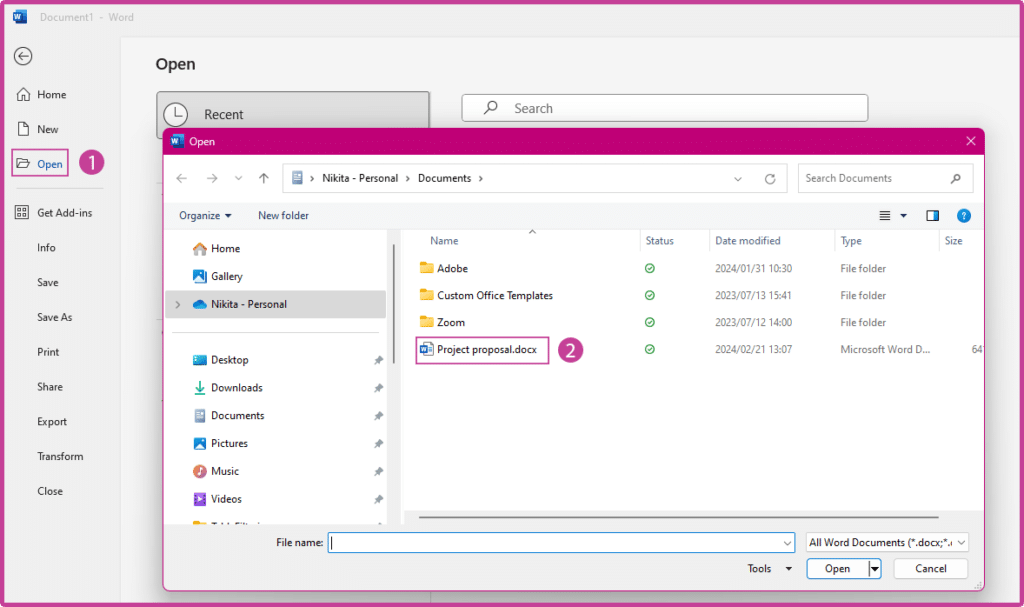Streamlining Data: A Step-by-Step Guide to Convert Word to Excel
Organizing business data ensures that teams work faster on projects. One way to put data in order is to keep it in programs that complement its purpose. We know that Microsoft Word is a powerful piece of software for creating, editing, and formatting text documents. It’s a super popular app because it lets teams collaborate on documents in real time.
However, Microsoft Word is not the program you want to work with if you need to organize data into lists or tables. Microsoft Excel is the application you need in this situation. It has the advanced tools you need to analyze and manipulate data quickly.
The best part about Microsoft Excel is that it integrates well with other software systems, like Salesforce. This makes it a good option for teams that work with business data. So, when you decide to convert a Word document into an Excel spreadsheet, you get to automatically sync that transferred data to other applications, like Salesforce or third-party data analysis software.
For these reasons, if you have table data in a Word document, we can understand why you want to convert it into an Excel spreadsheet.
Join us in the article below to learn how to convert a Word file to an Excel spreadsheet.
Change your Word Document into an Excel Spreadsheet
Most readers ask, “Can you convert a Word document to Excel? “. The answer is yes. But it’s a convoluted process where you need to convert your file to a .csv document.
Nimble document generation software can help you automatically achieve this task. Here are a few applications that can covert a Word doc to Excel:
The process to convert a Word document to Excel without software is not that easy. Follow our step-by-step guide below.
Open a Word Document
To start, switch to your Microsoft Word program and open the document that you would want to convert to an Excel spreadsheet.

Save the Document
Check that it is the correct document you want to transform, and then save it as a Plain Text file.

Open up your Excel Sheet and Select ‘Data’
Now, head over to Microsoft Excel and click on Data in the menu to import your Plain Text document.

Choose your Word Document from “From Text/CSV”
Select your Plain Text document and preview the data format and structure before clicking Load.

And now, you can edit and analyze data with Excel’s features and tools.
How to Convert a Word Table to Excel?
Many researchers prefer to use Microsoft Excel to calculate data. Hence, working with table data in Microsoft Word is not ideal. The software does not have calculation or analysis tools to assist reports. So, we understand why you would want to convert a table in Word to Excel.
Here is a quick guide to show you how to convert Word data into an Excel table. Your researchers can then easily go ahead and analyze data or create charts for stunning and easy-to-understand reports.
The first approach you could take is to copy the Word table and paste it directly into a new Excel spreadsheet using the keyboard shortcuts Ctrl + C (copy) and Ctrl + V (paste).
Certainly, this is a faster method than retyping all data into a spreadsheet. But, it’s important to note that the data in each cell from Word is placed in an individual cell in Excel when using the copy-paste method.
Convert Word to Excel with Formatting
Although this is a fast procedure to move your table data into Excel, it’s essential to remember that the data might be transferred in a messy state. We suggest saving some time to go through the data, clean it, and prepare it for analysis in Excel.
You can format your table in Excel by clicking next to your data and selecting Paste Options. Choose Match Destination Formatting if you want to keep the structure as is. Alternatively, pick Keep Source Formatting if you want to match the data structure to its original Word document format.
If you want to convert Excel data into a Word table, you can follow the same copy-paste method, but this time, copy the table from Excel and paste it into Word.
Titan for Automated File Management Tasks
In this competitive market, tasks need to be done faster. The way forward is with document workflow automation software. Titan can get your Word documents, Excel worksheets, PDFs, and more pushed and pulled into Salesforce in real time.
Our no-code platform automates every stage of your file journey to keep documents virus-free and ready for instant collaboration. If you work with Microsoft Office Suite and Salesforce daily, we suggest using Titan to automate advanced file management tasks. We can help you make Salesforce your source of truth for all files.
Key Benefits of Converting a Word Document to an Excel Worksheet
With Microsoft Excel, you can manipulate and format information with a host of tools to sort data and even remove track changes. Looking for important figures and working out calculations with formula tools is one of the advantages of using Excel instead of Word.
Let’s take a look at a few other ways you can speed up data analysis by working in Excel.
Easy Data Management
Microsoft Word manages text, whereas Excel works perfectly with statistics. When you convert Word documents that contain figures into spreadsheets, you can use Excel to clean and transform your data. The tools in Excel simplify data analysis compared to working in Word.
Use Formulas
Microsoft Word does not have tools to manipulate data with dynamic formulas. So, if you have data in Word, it’s best to transfer it to Excel, where you can seamlessly include formulas. Working with formulas in data analysis saves researchers time as they get to automate calculations.
Research teams also gain a professional and respected edge by using Excel formulas since these tools are accurate and fast compared to the usual manual calculation methods.
Use Titan Docs for Point & Click Salesforce Solutions
If you want to extend your document generation experiences with Word, Excel, and Salesforce, we suggest you check out Titan Docs.
Our app can automate any process you like with zero code and end-to-end security. Our Docs are 100% secure and compliant with HIPAA, SOC 2, ISO, GDPR, and other leading frameworks. If you are ready to say goodbye to paperwork, we’ve got you covered!
We can offer you end-to-end processes, starting with building custom contracts, reports, proposals, quotes, and invoices directly from Salesforce in minutes and seconds — all without a single line of code.
Our advanced document generation tools let you read any field from any object or report in Salesforce and display it in any format. You can also add interactive capabilities that allow you to write data directly from your document to any object in Salesforce. Work with standard or custom objects and any data structure you choose.
Then, push your files to Salesforce to save and share them with Titan’s powerful automation tools.
With Titan, you nuke manual paperwork and optimize efficiency. We integrate with Word, Excel, Salesforce, and your third-party storage app of choice for the best user experience.
Smart Features from Titan for Document Management Processes
Titan is perfect for day-to-day administration tasks. For example, you can use Titan Docs to generate Word documents from Salesforce. These files can be converted to a PDF format with pre-filled dynamic data for easy sharing.
You can also merge multiple documents into one file and convert it in seconds. We can transform files into any format so you can have complete control of how you work with files. Titan can convert documents into PDF, DOCX, HTML, and PNG file formats.
Titan lets you connect barcodes and QR codes embedded in your documents to Salesforce. This feature supports paperless payment processes. Add these Salesforce-mapped elements to invoices and other documents to speed up order processing workflows. It’s a sure way to make faster financial transactions.
You don’t have to save your files only in Salesforce. We know that Salesforce has size limits, and storing every business document here can raise financial and software issues. When you sign up for Titan, you can archive files in many locations from Salesforce, as we integrate with Google Drive, Box, Dropbox, OneDrive, and many more third-party apps!
Frequently Asked Questions
How to convert Word to Excel online?
You will need specific software to help you convert Word documents to Excel worksheets. Adobe is a reliable application to use to get the job done, but choose the software that aligns with your systems and project requirements.
Analyzing or editing table data in a Word document is not easy, so we understand why you want to convert your file to a spreadsheet.
Start by installing an app like Adobe’s Word to PDF converter. You will need to upload your Word document into this app and follow the prompts to transform it into a PDF. Save this PDF somewhere safe and then install Adobe’s PDF to Excel tool. It will allow you to change your document from a PDF to an Excel spreadsheet.
If you want, you can download your Excel file and archive it to work in offline conditions. However, for this last step, you might need to sign up for an Adobe account.
How to convert word to number in Excel?
When you see Excel alerting you to change your word or text data into numbers, simply pick your cells and click on the alert icon. When the menu options pop up, select Convert to Number. The data in your cell will now be left-aligned, and the error alert disappears.
If you notice that you are not receiving alerts from Excel to change words to numbers in a formatted cell, then you can enable the button by navigating to Preferences in the menu bar.
Then, select Formulas and Lists so you can enable Error Checking. Remember to also turn on the Enable Background Error Checking checkbox.
How to align docs with copied columns from Sheets?
There are many tools to choose if you want to align copied columns from Google Sheets in your documents. Make sure to select the one that aligns with your project requirements. But to apply it on a general level, we have provided a simple guide:
-
- Copy the columns in Google Sheets by selecting them and pressing Ctrl + C on your keyboard. If you are on a Mac, you can use the Command + C shortcut. Alternatively, right-click on the columns and select Copy.
- Open up the document you want to copy the columns into, like Microsoft Word.
- Paste the columns into the document with Ctrl + V or Command + V. Like the copy method, you can use your mouse instead by right-clicking in the document and selecting Paste from the menu.
- Now, you can choose to format these columns by adjusting their width, the styles of fonts, and the size of elements. These formatting options help to align and style your columns with the other content in your document.
- Once you are done formatting the columns, double-check that you are happy with the edits and save your document.
Unbelievable Document Automations with Titan & Salesforce
Thanks for reading our article on how you can transfer data between Microsoft Word and Excel. If you would like seamless data transfers between Salesforce and these two powerful pieces of software, we suggest checking out Titan.
Our platform gives you the power to create dynamic documents for every use case across all industries. We can help you connect your third-party apps to Salesforce for complex document flows between colleagues and customers.
Titan is number 1 on the Salesforce AppExchange marketplace as we provide advanced features like QR codes, bar codes, and digital signatures to add to documents. Salesforce users love that they can work with documents in multiple formats with access to using dynamic content in projects. We also secure the information in documents with access permissions so teams can collaborate and share work confidently.
For more information about streamlining experiences for document workflows, contact us through one of our social media channels.
We hope to see you soon!

Disclaimer: The comparisons listed in this article are based on information provided by the companies online and online reviews from users. If you found a mistake, please contact us.



